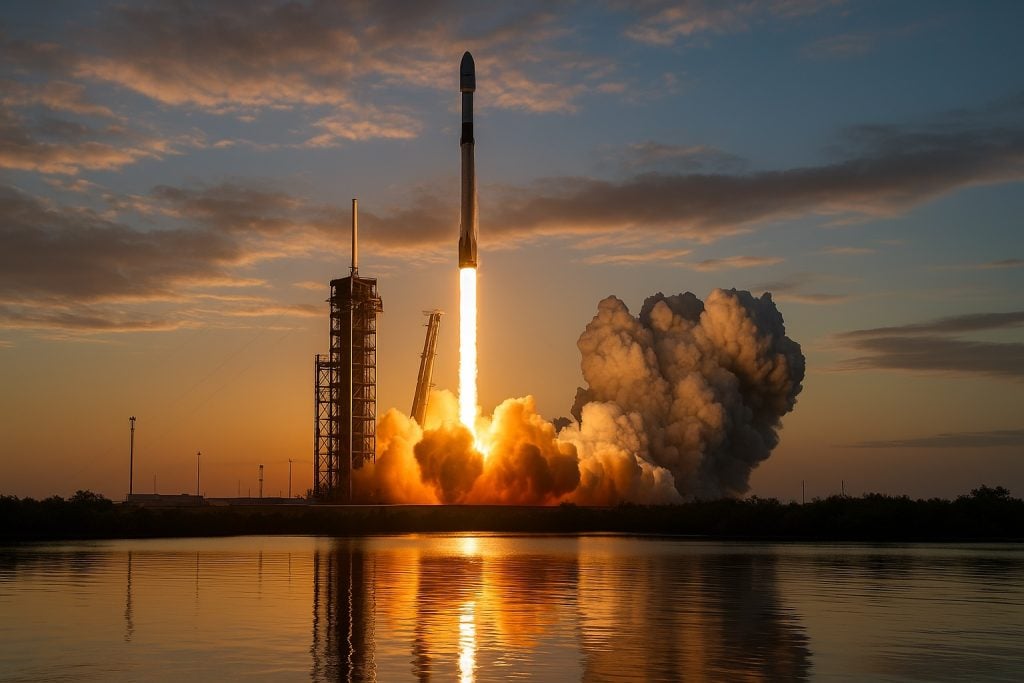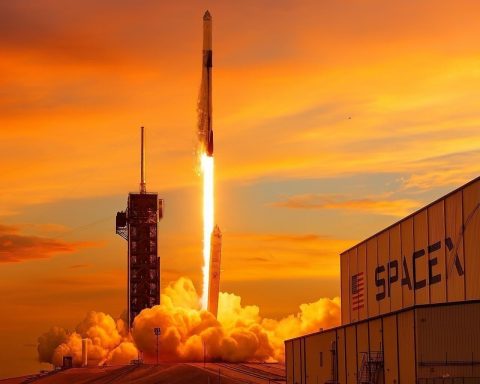- Starship is a two-stage, fully reusable rocket system about 120 meters tall, with 33 Raptor engines on the Super Heavy booster and 6 Raptors on Starship, delivering roughly 74 MN of thrust.
- The first orbital-class flight occurred on April 20, 2023 from Starbase with Ship 24 atop Booster 7, cleared the pad but failed to separate stages and was terminated, yet SpaceX called it a success for pad clearance.
- On November 18, 2023 (Flight 2), SpaceX conducted hot staging with a 33-engine Super Heavy (B9), achieved stage separation, but the booster exploded on return due to a clogged fuel filter and the Starship upper stage was destroyed by the flight termination system after about six minutes in space.
- March 14, 2024 (Flight 3) saw Booster 10 and Ship 28 reach space and orbital velocity, effectively circumnavigating much of the globe before reentry, while Ship 28 lost telemetry and broke up and the booster was destroyed by engine-relight issues.
- June 6, 2024 (Flight 4) completed the first full end-to-end flight, with Booster 11 and Ship 29; the booster splashdown offshore in the Gulf of Mexico and the Starship belly-flopped into the Indian Ocean, with both stages later destroyed on water.
- October 13, 2024 (Flight 5) saw Booster 12 catch on Starbase’s tower arms for the first time, while Ship 30 exploded on water, marking a milestone in booster catch attempts.
- November 19, 2024 (Flight 6) carried a stuffed plush banana as a zero-G indicator on Booster 13 and Ship 31, the booster splashed down and Ship 31 survived reentry, and the mission tested Starlink deployment mechanisms while retiring the Block 1 design after six flights.
- January 16, 2025 (Flight 7) introduced Block 2 with Booster 14 catching on the tower, but Ship 33 suffered a propellant leak causing harmonic vibration, telemetry was lost, and the automated flight termination system destroyed the Starship with no payload deployed.
- March 2025 (Flight 8) featured Booster 15 catching again, but Ship 34 endured a hardware failure on a center engine early in ascent, the ship was destroyed, while the booster still landed on the tower arms after two of its four engines failed to reignite.
- May 27, 2025 (Flight 9) attempted a reflight of Booster 14 with Ship 35, but the mission ended with the booster exploding about 1 km above the Gulf of Mexico during a downrange water landing test and Ship 35 breaking apart on reentry over the Indian Ocean, with no payload deployed.
Background: From Concept to First Launches
SpaceX’s Starship program emerged from CEO Elon Musk’s vision of a fully reusable spacecraft to carry humans to Mars. Initially dubbed the Mars Colonial Transporter and later BFR, the vehicle was renamed Starship around 2018. Development ramped up at SpaceX’s Boca Chica site in Texas (now “Starbase”), where early prototypes made low-altitude hops in 2019–2020. By 2021, test articles like SN8 and SN9 performed high-altitude flights with the trademark “belly-flop” descent, validating Starship’s novel landing maneuver despite explosive landings. In May 2021, SN15 finally stuck the first successful landing, proving the basic design [1].
Starship’s first orbital-class test flight came on April 20, 2023, with a full stack (Starship upper stage Ship 24 atop Booster 7) lifting off from Starbase. This 120-meter-tall rocket became the most powerful ever launched, producing ~16 million pounds of thrust at liftoff [2]. The maiden flight cleared the pad but suffered engine outages and failed to separate stages, leading SpaceX to trigger the flight termination system. The gigantic vehicle was destroyed about four minutes into flight [3] [4]. Despite the dramatic mid-air breakup, SpaceX declared the test a success since it “cleared the pad”, achieving the primary goal of avoiding pad destruction [5]. However, the launch showered the pad with debris and carved out a large crater, prompting an FAA-supervised mishap investigation and environmental scrutiny [6] [7].
After reinforcing the launch mount (including a new steel water-deluge plate to prevent another “rock tornado” of concrete) [8], SpaceX tried again on November 18, 2023. This second test flight introduced a hot staging technique (lighting Starship’s engines before stage separation) and the upgraded pad systems. The Super Heavy booster (B9) performed better, firing all 33 engines and successfully separating Starship in flight [9] [10]. However, the booster exploded during their return burn due to a clogged fuel filter and engine failure, and the Starship upper stage also lost control after six minutes in space, ultimately being destroyed at ~148 km altitude by its flight termination system [11] [12]. Despite the loss, Flight 2 demonstrated key milestones like stage separation and informed many upgrades for subsequent attempts.
Starship and Super Heavy: Design & Specs
Starship is a two-stage, fully reusable rocket system intended to revolutionize launch costs and capacity. The combined vehicle stands about 120 m (394 ft) tall with Starship (the upper stage spacecraft) atop the Super Heavy first-stage booster [13]. Both stages are constructed from stainless steel, giving Starship its distinctive shiny appearance and strength to endure reentry heat. Raptor engines – advanced liquid methane/liquid oxygen (Methalox) engines – power both stages. The Super Heavy booster carries 33 Raptor engines (sea-level optimized), while the Starship spacecraft has 6 Raptors (3 sea-level and 3 vacuum optimized) for propulsion in space and landing burns [14] [15]. Together, this system produces ~74 MN of thrust (over 16 million pounds), making Starship the most powerful rocket ever built [16].
Capacity: Starship is designed to loft enormous payloads – 100 to 150 metric tons to Low Earth Orbit (LEO) in a fully reusable configuration [17]. If refueled in orbit, Starship could send substantial masses to the Moon or Mars. The spacecraft features a spacious payload bay (~9 m diameter) that can carry bulk cargo or dozens of satellites at once. For crewed missions, SpaceX plans to outfit Starship’s interior with life support systems and cabins, potentially accommodating 100 passengers for Mars flights.
Reusability: Every aspect of Starship prioritizes reuse to slash costs. SpaceX aims to reuse both stages rapidly, unlike any previous orbital rocket [18] [19]. The Starship upper stage is protected by thousands of black heat shield tiles to survive atmospheric reentry and designed to perform tail-first propulsive landings back on Earth (much like Falcon 9 boosters). Super Heavy boosters will descend back and be caught by a pair of giant tower arms at the launch site, eliminating the need for expendable landing legs [20]. This bold catch system – nicknamed “Mechazilla” – was first demonstrated in 2024 when SpaceX caught a returning booster using the launch tower arms [21] [22]. Engineers also plan to eventually catch the Starship spacecraft itself or have it land back on a pad for quick turnaround [23].
Other notable design elements include large moving fins on the Starship (two forward canards and two aft flaps) that steer the ship during its hypersonic belly-flop reentry, maintaining stability and distributing heat. The latest Starship iterations (Block 2 vehicles in 2025) sport enhancements like a more robust heat shield and stronger flaps to endure intense reentry stress [24]. The stack uses an automated flight computer and has an autonomous flight safety system for range safety (as seen when the system terminated flights that deviated from course).
Launch Infrastructure at Starbase and Beyond
SpaceX conducts Starship launches from its Starbase facility in Boca Chica, Texas, which hosts the first orbital launch pad (OLP-1). The site features a massive orbital launch mount and integration tower nearly as tall as the rocket itself. This tower is equipped with “chopstick” catching arms that lift, stack, and recover Starship vehicles. The pad infrastructure is uniquely complex: it must fuel the rocket’s huge propellant tanks (with subcooled liquid methane and oxygen), manage intense acoustic and thermal forces, and enable rapid reusability. After the destructive first launch, SpaceX installed a steel water-cooled flame deflector system under the mount to protect the pad and surrounding wildlife [25] [26]. Subsequent launches have validated this upgrade, as later Starship liftoffs did not dig out craters or hurl debris like the first attempt.
Recovery Systems: Unlike Falcon 9’s downrange landing barges, Starship is designed to return to the launch site. The Super Heavy booster uses grid fins for atmospheric control and performs a boost-back maneuver to fly to Starbase. In 2024, SpaceX proved it could precisely fly the 70-meter booster back and perch it onto the tower arms for a catch – a dramatic feat first accomplished on Flight 5 in October 2024 [27]. By early 2025, a total of three Super Heavy boosters had been successfully caught by the Starbase tower after launch [28] [29]. The Starship upper stage has so far been expended on test flights (splashing down in the ocean), but future plans call for Starships to return to either the launch site or an ocean platform for reuse. SpaceX at one point acquired floating oil rigs to convert into offshore Starship platforms, and it continues to build a second launchpad at Kennedy Space Center’s Pad 39A in Florida for orbital Starship missions [30].
Launching such a giant rocket requires significant ground support: a large tank farm of fuel/oxidizer, cooling systems, and quick-disconnect arms to fuel the vehicle up to the moment of launch. Starbase’s remote location (near the Gulf and Mexican border) was chosen to allow rockets to launch eastward over water, but it’s also adjacent to sensitive wildlife areas. This has drawn environmental oversight – the FAA conducted extensive environmental assessments before permitting launches, and after the first launch’s debris, several environmental groups even sued the FAA for not adequately protecting the area [31] [32]. SpaceX has had to coordinate closely with the FAA, Fish and Wildlife Service, and other agencies to mitigate impacts (like timing launches outside nesting season and cleaning up debris). The company’s rapid-iteration approach has at times clashed with regulatory pace, leading to some launch license delays, but improvements to the pad and flight safety systems have gradually won approval for continued testing [33] [34].
Ambitious Missions: Moon, Mars, and More
The Starship architecture is central to SpaceX’s long-term mission: making humans a multi-planetary species. Elon Musk has repeatedly stated that Starship’s ultimate goal is to enable a city on Mars, ferrying large numbers of settlers and cargo to the Red Planet in the coming decades [35] [36]. Starship is the vehicle Musk founded SpaceX to build – it’s supposed to make Mars colonization feasible by dramatically lowering the cost per ton to space and by being refueled in Earth orbit for interplanetary journeys [37]. In September 2024, Musk even outlined a plan: launch up to five uncrewed Starships to Mars in the next transfer window (late 2026), and if those land successfully, attempt a crewed Mars mission about two years later [38]. (Musk tempered that timeline by noting if major challenges arise, the crewed mission could slip an additional two years.) Such timelines are aspirational – Musk’s target dates often shift – but they underscore SpaceX’s drive to push Starship toward Mars as soon as technically possible.
More immediately, Starship is pursuing a range of missions in Earth orbit and the Moon:
- Satellite Deployment: Starship can deploy massive satellite payloads or many satellites at once. SpaceX plans to use Starship to launch the next generations of its Starlink internet satellites, which are larger and heavier than Falcon 9 can efficiently carry. In fact, the success of Starlink (a major revenue source for SpaceX) is tied to Starship’s greater lift capacity [39] [40]. With Starship, SpaceX could launch dozens of Starlinks in one go, lowering per-satellite costs. Commercial satellite operators are also eyeing Starship – the Japanese company SKY Perfect JSAT has booked a Starship launch for a large telecom satellite in the mid-2020s [41]. The rocket’s huge fairing (approximately 9 meters in diameter) can accommodate large space telescopes, space station modules, or multiple heavy satellites in a single launch. This opens possibilities for deploying hardware in orbit that previously would have required multiple launches.
- Human Spaceflight & Space Tourism: Starship is being developed to carry people, potentially 100 or more at a time for future Mars trips. In the nearer term, it’s slated for space tourism flights. One high-profile mission was the “dearMoon” project, where Japanese billionaire Yusaku Maezawa booked a Starship flight around the Moon carrying artists. Originally planned for 2023, dearMoon faced delays due to Starship’s development. By mid-2024, Maezawa canceled the planned trip citing schedule uncertainty and the need to wait until the rocket is fully ready [42]. Another private effort, the Polaris Program led by astronaut Jared Isaacman, envisions a Starship flight with a crew to high Earth orbit as soon as Starship is human-rated. These missions reflect significant commercial interest in Starship for adventure and research flights once safety is proven.
- NASA Artemis – Lunar Landing System: SpaceX’s Starship won NASA’s competition to serve as the first crewed Moon lander of the Artemis program. In April 2021, NASA selected a specialized Starship variant (the Starship HLS – Human Landing System) to land astronauts on the Moon for Artemis III, beating out other bidders [43] [44]. This lunar Starship will act as a ferry carrying astronauts from lunar orbit (where they arrive via NASA’s Orion capsule) down to the Moon’s surface and back. The HLS Starship is modified for space only – it will not reenter Earth’s atmosphere but will dock with Orion or the Lunar Gateway station. Notably, it forgoes flaps and heat tiles, adds extra landing thrusters high on its body (to avoid blasting the Moon’s surface), and features an elevator to lower astronauts to the ground (since Starship is ~50 meters tall). NASA’s confidence in Starship is significant: the agency views it as enabling a sustainable lunar program due to its payload capacity. Artemis III, originally slated for 2025, has now been officially pushed to no earlier than 2027 in part because of Starship’s development delays [45]. NASA also contracted SpaceX for a second crewed landing (Artemis IV), and plans to use multiple Starship launches for each lunar mission – one Starship HLS carrying crew, and several Starship tanker flights to refuel it in Earth orbit so it has enough fuel to reach the Moon and return [46] [47]. Each lunar landing may require up to a dozen tanker Starships to fully fuel the lander in orbit [48] [49], an unprecedented logistical feat that SpaceX must demonstrate with orbital refueling tests by 2026 [50].
- Beyond the Moon – Mars and Deep Space: In the late 2020s, SpaceX aims to leverage Starship for uncrewed Mars landings. In fact, SpaceX indicated plans to send around five Starships to Mars in 2026 (the next viable launch window) to drop off initial cargo and experiments [51]. This would include a mix of Starship landers and possibly a propellant depot in Earth orbit to support the Mars transit [52]. International partners are already showing interest: for example, the Italian Space Agency contracted SpaceX to deliver some experiments to Mars on that first Starship convoy [53]. Looking further, if Starship’s reusability pans out, it could carry probes to outer planets at lower cost, enable space telescopes larger than ever built, and even attempt point-to-point travel on Earth (flying between distant cities in under an hour via suborbital Starship flights), a concept SpaceX has floated as a future commercial use.
Financing and Commercial Impact
SpaceX is banking on Starship to dramatically reduce the cost of reaching orbit, which could upend the economics of the space industry. The company has invested heavily in Starship’s development – estimates run in the several billions of dollars – funded partly by SpaceX’s profitable Falcon 9 launches and Starlink satellite business, as well as a $2.9 billion NASA contract for the Human Landing System. In return, Starship promises massive economies of scale: Musk has said Starship’s marginal cost per launch (mainly fuel and refurbishment) could be just a few million dollars, carrying payloads 5–10 times larger than Falcon 9. This yields an astonishing projected cost drop – from current ~$1,000+ per kg launch prices down to possibly $10–$100 per kg of payload [54]. If achieved, such low costs would be revolutionary, enabling ventures that are uneconomical today. SpaceX’s strategy is to build Starships quickly on a production line (much like airplanes), accepting higher upfront costs to iterate rapidly and then reap savings by flying each vehicle many times.
Launch Market Disruption: With its heavy lift and low cost, Starship could capture a large share of the commercial launch market. Operators of large satellites or constellations may prefer bundling payloads on a single Starship launch rather than multiple smaller rockets. SpaceX has already signed at least one known commercial customer (JSAT’s Superbird-9 satellite launch in the mid-2020s) [55]. Additionally, SpaceX itself will be Starship’s biggest customer through Starlink: launching thousands of second-generation satellites and even deploying Starlink to Mars or the Moon in the future. Starship could also support national security launches – the U.S. military has been studying concepts for rapid global cargo delivery using SpaceX’s big rocket. (The Air Force’s “Rocket Cargo” program envisions rockets like Starship ferrying supplies or personnel across Earth in minutes, though this is still in experimental phases.)
Economic Viability: Reusability is key to Starship’s business case. SpaceX demonstrated with Falcon 9 how refurbishing rockets can save money, but Starship pushes this further by aiming to reuse the entire vehicle very frequently. Gwynne Shotwell (SpaceX President) has suggested Starship could ultimately fly hundreds of times before retirement. Musk has even set an ambitious target of eventually launching 1000 Starships per year (across a fleet) to spread out fixed costs and meet demand [56]. These figures may be far in the future, but they underscore SpaceX’s intent to make Starship akin to a workhorse fleet of orbital freighters, enabling an industrial scale of activity in space. If Starship delivers even a fraction of its promised cost reduction, it could pressure other launch providers – making it hard for expendable rockets (or even smaller reusable ones) to compete on price.
It’s worth noting that SpaceX’s rapid test-and-fail approach, while speeding development, carries financial risk. Each Starship test that ends in an explosion means lost hardware. However, SpaceX’s philosophy is that learning from failures early will prevent bigger costs later. As one space industry analyst observed, “One of SpaceX’s secret sauces is an acceptance of failure as a means to an end.” [57] This approach, coupled with SpaceX’s private funding and revenue from Starlink and Falcon launches, has allowed Starship development to forge ahead without immediate profitability. In the long run, Musk envisions Starship launches (especially for Starlink deployment) bringing in substantial revenue that makes the whole program sustainable [58].
Test Flights and Progress in 2024–2025
After the second flight in late 2023, SpaceX entered 2024 eager to reach orbit and start reusing Starships. The third test flight took place on March 14, 2024, and marked a major milestone: Starship reached space. Booster 10 and Ship 28 lifted off from Starbase, achieved stage separation, and the Starship stage attained orbital velocity for the first time [59] [60]. SpaceX confirmed the vehicle “reached orbital speed” on this flight [61], effectively circumnavigating most of the globe before reentering. During reentry over the Indian Ocean, however, the Ship lost telemetry and apparently broke apart before its planned splashdown [62]. The booster, meanwhile, attempted a landing splashdown in the Gulf of Mexico but was destroyed just above the water due to engine relight issues [63] [64]. Despite losing both stages, Flight 3 was considered a success because it demonstrated a full-duration second stage burn and collected critical reentry data [65] [66]. Observers hailed it as proof that Starship’s fundamental design works: “failing forward at its finest,” as Ars Technica’s Eric Berger quipped [67].
With confidence from Flight 3, SpaceX pushed to refine Starship’s recovery. The fourth test flight on June 6, 2024 saw Booster 11 and Ship 29 follow a similar suborbital trajectory but aim for controlled landings. In a spectacular achievement, the booster performed a precise splashdown just offshore, hitting a “virtual target” in the Gulf of Mexico, while the Starship stage reentered successfully and softly belly-flopped into the Indian Ocean (within a few kilometers of the aim point) [68] [69]. Both stages were destroyed on water impact, but importantly remained intact through reentry and descent, proving the vehicles could survive the return from space. This was Starship’s first full end-to-end test flight – nearly completing all planned phases [70]. Reuters reported the June flight as a “breakthrough landing demonstration,” as the Starship survived a fiery hypersonic reentry and splashed down after traveling around the globe [71]. Flight 4’s success set the stage for attempting full recovery on land.
On October 13, 2024, SpaceX conducted Flight 5 (Booster 12, Ship 30) which finally attempted the audacious booster catch. After a nominal launch and stage separation, Booster 12 flipped and navigated back to the pad. In a nail-biting moment, the giant booster descended onto Starbase’s tower arms and was successfully caught – the first time a rocket booster had ever been recovered by catching instead of landing [72] [73]. This engineering feat elicited celebration from SpaceX and NASA alike. “Congratulations to @SpaceX on its successful booster catch and fifth Starship flight test today!” NASA Administrator Bill Nelson wrote, noting each test brings us closer to the Moon and Mars [74] [75]. The Starship second stage in Flight 5 also performed well: it coasted for an hour, reentered over the Indian Ocean, and executed a landing burn to target a splashdown point with high precision [76] [77]. The Ship 30 stage did explode upon impacting the water (caught on a buoy camera) [78] [79], which was expected due to the lack of legs or a deceleration system. Still, Flight 5 demonstrated that both stages could be brought back in a controlled manner – a huge step toward full reusability.
Flight 6 followed on November 19, 2024 (Booster 13, Ship 31) as the last of the initial “Block 1” Starships. This mission carried Starship’s first test payload: a stuffed plush banana, serving as a zero-g indicator and bit of humor [80] [81]. The launch was successful and, like Flight 5, aimed to catch the booster. However, at liftoff one of the pad’s catching arms was slightly damaged, so SpaceX diverted the booster to a safe splashdown rather than risk the tower [82] [83]. The Starship stage performed an in-space engine relight test and reentered during daylight – the first daytime reentry of a Starship [84]. Even with some heat shield tiles intentionally removed (to test tolerances), Ship 31 survived reentry with minimal damage [85] [86]. The mission proved out additional objectives, like testing the Starlink satellite deployment mechanism’s door (though no actual satellites were released) [87] [88]. With that, SpaceX retired the Block 1 vehicle design, having flown six times in 2023–24 [89] [90]. Starship had achieved partial reusability (boosters recovered twice) and was ready for upgrades.
Entering 2025, SpaceX debuted the improved Block 2 Starship on Flight 7 (January 16, 2025). Block 2 featured structural and avionics upgrades, aiming to address previous issues [91] [92]. It also carried the first simulated satellite payloads: ten Starlink mass simulators (~20 tons) stowed in the nose [93] [94]. The launch started well – Booster 14 (new Block 2 booster) performed nominally and was caught successfully by the tower on return, making it the second booster catch to date [95] [96]. However, the Starship upper stage (Ship 33) ran into trouble a few minutes into its burn. Several of its six engines shut down prematurely due to what SpaceX later described as a propellant leak leading to a damaging “harmonic” vibration [97] [98]. Telemetry was lost, and the vehicle started tumbling. For safety, the automated flight termination system self-destructed the Starship over the Atlantic, raining debris into the ocean and briefly prompting airspace closures in Florida and the Caribbean [99] [100]. No payloads were deployed. While disappointing, the failure provided data that led to design tweaks (e.g. adding fire suppression in engine bays and larger venting for gases, per Musk’s comments) [101] [102]. It also demonstrated the system’s safety: the booster was recovered intact even when the ship failed.
Flight 8 in March 2025 (Booster 15, Ship 34) saw a similar profile with four Starlink simulators. Again the booster return was executed and caught without issue – by now SpaceX had three tower catches under its belt [103] [104]. But the Starship stage suffered a hardware failure on one of its center engines shortly into ascent, causing a loss of control [105] [106]. The ship spun out and was destroyed by range safety. Notably, even with two of its engines failing to reignite, the booster still managed to adjust its flight and land on the tower arms – showcasing resilience in the face of engine-out scenarios [107] [108].
By the ninth test flight on May 27, 2025, SpaceX attempted a major reusability milestone: re-flying a previously caught booster. Booster 14, which had been caught on Flight 7, was refurbished and paired with a new Ship 35 for Flight 9 [109] [110]. This marked the first reuse of a Super Heavy booster. The launch demonstrated the viability of turnaround: B14 completed ascent and separated normally [111] [112]. To push its limits, SpaceX did not catch the booster this time – instead, they commanded it to attempt a controlled water landing downrange, to test high-stress reentry dynamics [113] [114]. The booster angled itself steeply during descent to maximize drag (and stress). It managed to reignite 12 of 13 landing engines, but about 1 km above the Gulf of Mexico the booster exploded – investigators believe the extreme forces caused an internal propellant line to rupture, leading to the blast [115] [116]. Meanwhile, the Starship upper stage reached space and nearly completed its mission: it cut off its engines at the intended velocity, but failed to deploy the batch of eight Starlink dummy satellites on board due to a fuel leak and pressurization fault [117] [118]. With its mission compromised, the ship was intentionally passivated (engines safed) and left to tumble back through the atmosphere. It broke apart on reentry over the Indian Ocean with no harm to populated areas [119] [120]. Though Flight 9 did not achieve a fully successful outcome, it was significant as the first reflight of Starship hardware, and it yielded insights into booster reentry dynamics that are driving design refinements (such as switching from four small grid fins to three larger ones for better control on future boosters) [121] [122].
After Flight 9, the FAA once again reviewed the mishaps. By August 2025, the FAA announced the closure of the Flight 9 failure investigation, approving SpaceX to move ahead with the next launch [123]. SpaceX stated it had traced the causes of Flight 9’s issues – separate structural problems in the booster and ship – and implemented fixes [124]. One intervening incident was a test stand explosion on June 18, 2025, which destroyed Ship 36 during a ground test and damaged nearby equipment [125]. This setback delayed the next flight schedule slightly as SpaceX repaired the pad and switched to Ship 37 for the upcoming mission.
As of late August 2025, SpaceX is preparing for Flight 10, aiming to finally accomplish several “long-sought development milestones” in one mission [126]. Objectives for Flight 10 include deploying Starlink satellites from Starship in space for the first time and performing a mid-flight engine relight on the ship to demonstrate orbital maneuver capability [127] [128]. The booster on Flight 10 is planned to perform a water landing again (to test a new engine out scenario) rather than a tower catch [129] [130]. With each iteration, SpaceX is learning and improving. Despite two early-flight failures and another in-space failure on Flight 9 this year [131] [132], the company continues to rapidly produce new vehicles and iterate its design. This test campaign – marked by spectacular explosions and breakthroughs alike – embodies SpaceX’s “test, fail, fix, repeat” ethos. As SpaceX operations engineer Siva Bharadvaj remarked during a launch webcast, “Many of the innovations we’ve developed have come from our failures.” [133] [134]
What Experts and Officials Say
The Starship program has drawn both awe and measured skepticism from aerospace experts. NASA leadership has generally been supportive, given that Starship is integral to Artemis plans. After SpaceX’s successful booster catch in 2024, NASA Administrator Bill Nelson congratulated the team, while cautioning that spaceflight is never routine. “Spaceflight is not easy. It’s anything but routine. That’s why these tests are so important—each one bringing us closer on our path to the Moon and onward to Mars through Artemis,” Nelson wrote in January 2025 [135]. This captured the mix of optimism and patience at NASA: Starship’s progress is exciting, but NASA is carefully watching to ensure safety and success before committing astronauts to it. Indeed, NASA has already adjusted its schedules – as of late 2024, the agency officially pushed the first crewed lunar landing (Artemis III) to no earlier than mid-2027, citing technical issues with Orion and the Starship lander [136] [137]. Former NASA Administrator Mike Griffin even told Congress he doesn’t find the Artemis III schedule “at all realistically scheduled” given the challenges [138] [139]. NASA’s Inspector General and the GAO have similarly warned that a 2025 or 2026 lunar landing is unlikely, implicitly because Starship may need more time to be ready [140] [141].
Many industry analysts and space journalists see Starship as a potential game-changer if it lives up to its promise. The sheer scale and reusability of the rocket could “transform life on this planet and beyond,” wrote analyst Peter Hague, arguing that cheap mass-to-orbit will enable rapid innovation in solving spaceflight’s hardest problems [142] [143]. The sentiment in the space community is that Starship’s success would mark a paradigm shift: dramatically greater payloads at orders-of-magnitude lower cost. As Ars Technica’s Eric Berger noted after Starship’s third flight, “This is failing forward at its finest… [It demonstrates] an acceptance of failure as a means to an end.” [144] In other words, SpaceX’s approach of iterating through test failures is seen as unconventional but potentially highly rewarding. Berger and others have pointed out that traditional aerospace methods (aiming for no failures) might never achieve the breakthroughs Starship is targeting. The rapid pace of Starship tests – nine flights in two years – is unprecedented for a rocket of this size, and it’s yielding data fast.
At the same time, critics and competitors highlight Starship’s risks. Environmental advocates worry about the impact on the fragile Boca Chica ecosystem and surrounding communities. After the first launch scattered debris and sparked a fire in a wildlife refuge, organizations like the Center for Biological Diversity argued FAA should have done a more rigorous Environmental Impact Statement. “It’s vital that we protect life on Earth even as we look to the stars… [Agencies] should not give a pass to corporate interests that want to use treasured coastal landscapes as a dumping ground for space waste,” said one group’s attorney, underscoring concerns about rocket debris and pollution [145]. These groups have taken the FAA to court to ensure stricter oversight. SpaceX has responded by engaging more with regulators and investing in mitigation (for example, building a water deluge system to significantly reduce pad debris and dust).
Internationally, Starship has turned heads in the global space race. Competitors in China, Europe, and the U.S. are keenly observing. In China, for instance, engineers have openly taken inspiration from SpaceX. In late 2024, China unveiled plans for its own fully reusable super-heavy rocket, remarkably similar to Starship in appearance and specs [146] [147]. The planned Long March 9 redesign features a two-stage rocket with methane engines (30 engines on the first stage) and Starship-like grid fins and flaps for reusability [148] [149]. Its dimensions (about 114 m tall, 150-ton payload) are close to Starship’s 120 m and 150-ton capacity [150]. This “Chinese Starship” is slated for the 2030s to support China’s lunar ambitions. “SpaceX continues to be a font of inspiration for Chinese aerospace engineers,” noted Space.com, reporting on how closely the new Long March design mirrors Starship’s features [151] [152]. This competition underscores that if SpaceX succeeds, other nations don’t want to be left behind in the capability gap.
Traditional launch providers are also adjusting. Blue Origin, led by Jeff Bezos, has been developing a heavy reusable rocket called New Glenn (expected to fly in the mid-2020s) and has floated concepts for an even larger fully-reusable rocket in the Starship class (sometimes dubbed “New Armstrong”). United Launch Alliance’s next-gen Vulcan rocket and Europe’s Ariane 6, however, are partially or fully expendable and far less powerful, prompting questions about their long-term competitiveness. Even NASA’s own Space Launch System (SLS) – a government-developed heavy rocket – faces scrutiny: SLS costs billions per launch for at most 130 tons to LEO, versus Starship’s anticipated much lower cost for similar or greater lift. While NASA is proceeding with SLS for now, some space policy experts have mused that a fully operational Starship could eventually render SLS obsolete for cargo, shifting NASA to buy Starship launches commercially. In Congress, however, SLS has strong political backing, and NASA emphasizes they are complementary (SLS launches crewed Orion, Starship handles lunar landing). It remains a debate for the future, hinging on Starship’s performance.
Challenges and The Road Ahead
Despite remarkable progress, Starship still faces critical challenges before it becomes an operational vehicle. Key hurdles include:
- Technical Reliability: Starship’s test flights have exposed issues that must be solved. Engine reliability is paramount – up to 33 Raptor engines must fire in unison, and any serious anomaly can doom a mission. The flights so far saw multiple engine-out situations and even structural resonances that caused vehicle loss [153] [154]. SpaceX will need to refine engine design, filtering systems (to stop debris clogging fuel lines as happened in Flight 2 [155]), and software to handle engine failures more gracefully. The stage separation via hot-staging, while now proven, is a complex, ultra-energetic maneuver that stresses the vehicle. Each flight also taught new lessons about aerodynamics (for instance, adjusting booster reentry angle to prevent internal pressure ruptures [156] [157]). Solving these will determine Starship’s reliability.
- Reentry and Reusability: Thus far, no Starship stage has been fully recovered intact from a flight. The booster catches have been successful, but a Starship spacecraft itself has not been re-landed yet (all have splashed down or broken up). The heat shield must demonstrate it can survive multiple orbital reentries without extensive refurbishment. Some Starships lost tiles or had flap damage from heating, though impressively one still managed a stable reentry with tiles missing [158] [159]. SpaceX will continue to iterate on tile attachment and perhaps material improvements. Additionally, the mechanism to catch the Starship on the launch tower (or otherwise land it precisely) remains to be tested – SpaceX has hinted it will attempt to catch an upper stage in late 2025 [160] [161]. Executing that safely is a huge challenge given the Starship’s size and speed on return. Until both stages are routinely recovered and reused, the economic advantage of Starship isn’t fully realized.
- Orbital Refueling: A cornerstone of Starship’s intended operations (for Moon and Mars missions) is the ability to refuel one Starship with another in orbit. This propellant transfer in microgravity is something never done before at scale. NASA has tasked SpaceX to conduct a demo of orbital refueling by 2026, involving one Starship docking with another and pumping over hundreds of tons of cryogenic propellant [162] [163]. The engineering challenges here include developing a zero-boiloff storage in orbit, plumbing for tank-to-tank transfer in micro-g, and preventing fuel loss or imbalance. Success in refueling is critical for lunar landing missions (which need a fueled-up HLS in lunar orbit) and for any Mars voyage.
- Regulatory & Environmental Concerns: SpaceX must continue navigating regulatory approvals for Starship launches. After the April 2023 pad devastation, the FAA grounded Starship for nearly 7 months until SpaceX completed dozens of corrective actions [164] [165]. Each failure that has off-nominal impacts (like debris falling outside expected zones, or the cloud of particulate matter from the first launch) risks further regulatory delays. Environmental lawsuits are still pending – a court could impose additional environmental impact requirements that slow operations at Boca Chica. Additionally, launching such a large rocket frequently raises range safety and airspace issues. During some tests (e.g. Flight 7’s anomaly), debris falling from high altitude led the FAA to temporarily halt flights at major airports in Florida [166] [167]. Managing airspace closures and ensuring public safety will be increasingly important as launch frequency ramps up. SpaceX will need to work closely with the FAA, and possibly shift more launches to the ocean or to SpaceX’s Cape Canaveral site, to mitigate local environmental and safety concerns in Texas.
- Schedule and Funding Pressure: Starship’s delays have knock-on effects. NASA’s Artemis III Moon landing timeline has slipped largely because Starship isn’t ready to carry astronauts yet [168]. If delays mount further, NASA might need contingency plans (like a non-landing Artemis mission or using an alternate lander for later missions). There’s pressure on SpaceX to deliver for NASA’s deadlines; conversely, NASA’s continued support (and payments) depend on seeing progress. On the commercial side, customers like Maezawa (dearMoon) already grew impatient and pulled back [169]. While SpaceX as a private company can accept high-risk testing, it eventually must demonstrate reliability to attract paying satellite customers (who need assurance their payload won’t be lost on an exploding test flight). The company’s enormous investment in Starship also assumes Starlink revenues and investor funding remain strong to cover development costs until Starship becomes profitable. Any faltering in SpaceX’s finances or a major failure that grounds Starship for a long period could pose programmatic risks.
- Competition and Geopolitics: As noted, Starship’s advent is prompting responses worldwide. If SpaceX dominates super-heavy launch capability, other countries may worry about an uneven playing field in space exploration and commerce. China’s accelerated reusable rocket plans [170] [171] are one response. There’s also the issue of dependence: NASA and U.S. security satellites could become dependent on a single private company’s rocket if Starship becomes the go-to for heavy lift. That raises policy questions about redundancy and oversight. Meanwhile, Europe has no comparable system on the horizon and risks falling behind in launch capacity, which could shift the center of gravity of the space industry towards those who have Starship-like vehicles. This competitive pressure could spur innovation (which is good for advancement) but also may introduce international tensions if, for example, Starship enables the U.S. to undertake lunar or Mars projects that others cannot easily match. Space policy experts are watching how quickly others can catch up or whether SpaceX will establish a long-term monopoly in ultra-heavy launch services.
Outlook: The next 1–2 years will be crucial in proving Starship’s readiness. SpaceX officials, such as Starbase director Kathy Lueders, have expressed optimism – in late 2024 she said SpaceX hopes to conduct as many as 25 Starship launches in 2025 and even attempt catching a Starship with the tower in that timeframe [172]. Whether that aggressive cadence is achievable remains to be seen, but SpaceX is clearly moving rapidly. Each test flight, even the failures, has yielded valuable data and often incremental progress (from clearing the pad, to separating stages, to catching boosters, etc.). The world is watching to see if Starship’s “rapid reusability” can be fully realized. If it is, we could enter an era of spaceflight where launching 100 tons to orbit is routine and affordable – fundamentally altering what humanity can do in space. Missions like building lunar bases, transporting large habitats to orbit, or sending fleets of robots and people to Mars become vastly more practical with a vehicle like Starship in service.
In summary, SpaceX Starship represents a bold leap in rocket technology. Its development has been marked by spectacular tests, iterative engineering, and a vision to make space accessible on an unprecedented scale. Major milestones – from the first orbital flight to the first booster catch – have now been checked off [173] [174]. Still, significant work lies ahead to overcome technical and regulatory challenges. As SpaceX continues its fast-paced testing into 2025, Starship is inching closer to operational status. If Starship succeeds, it could enable missions that once seemed like science fiction, from sustainable Moon bases to Mars colonies – truly changing the trajectory of human space exploration [175]. The coming years will prove whether this stainless-steel behemoth can deliver on its promise to “fundamentally change and enhance humanity’s ability to reach space,” as SpaceX boldly proclaims [176] [177]. All eyes are on Starship as it strives to turn its early stumbles into the stepping stones of a new spacefaring era.
Sources: SpaceX, NASA, Reuters, Spaceflight Now, Space.com, Business Insider, AP News, Wikipedia [178] [179] [180] [181] [182], and more as cited throughout.
References
1. quillette.com, 2. www.businessinsider.com, 3. en.wikipedia.org, 4. en.wikipedia.org, 5. en.wikipedia.org, 6. www.kwqc.com, 7. www.kwqc.com, 8. www.kwqc.com, 9. en.wikipedia.org, 10. en.wikipedia.org, 11. en.wikipedia.org, 12. en.wikipedia.org, 13. www.reuters.com, 14. en.wikipedia.org, 15. en.wikipedia.org, 16. www.businessinsider.com, 17. www.space.com, 18. en.wikipedia.org, 19. en.wikipedia.org, 20. en.wikipedia.org, 21. en.wikipedia.org, 22. en.wikipedia.org, 23. en.wikipedia.org, 24. www.reuters.com, 25. www.kwqc.com, 26. www.kwqc.com, 27. en.wikipedia.org, 28. www.space.com, 29. www.space.com, 30. en.wikipedia.org, 31. www.kwqc.com, 32. www.kwqc.com, 33. www.space.com, 34. www.space.com, 35. www.reuters.com, 36. www.businessinsider.com, 37. www.businessinsider.com, 38. www.reuters.com, 39. www.reuters.com, 40. www.reuters.com, 41. en.wikipedia.org, 42. www.reuters.com, 43. en.wikipedia.org, 44. en.wikipedia.org, 45. en.wikipedia.org, 46. en.wikipedia.org, 47. en.wikipedia.org, 48. en.wikipedia.org, 49. en.wikipedia.org, 50. en.wikipedia.org, 51. en.wikipedia.org, 52. en.wikipedia.org, 53. en.wikipedia.org, 54. quillette.com, 55. en.wikipedia.org, 56. quillette.com, 57. www.businessinsider.com, 58. www.businessinsider.com, 59. en.wikipedia.org, 60. en.wikipedia.org, 61. en.wikipedia.org, 62. en.wikipedia.org, 63. en.wikipedia.org, 64. en.wikipedia.org, 65. en.wikipedia.org, 66. en.wikipedia.org, 67. www.businessinsider.com, 68. en.wikipedia.org, 69. en.wikipedia.org, 70. www.reuters.com, 71. www.reuters.com, 72. en.wikipedia.org, 73. en.wikipedia.org, 74. www.astronomy.com, 75. spaceflightnow.com, 76. en.wikipedia.org, 77. en.wikipedia.org, 78. en.wikipedia.org, 79. en.wikipedia.org, 80. en.wikipedia.org, 81. en.wikipedia.org, 82. en.wikipedia.org, 83. en.wikipedia.org, 84. en.wikipedia.org, 85. en.wikipedia.org, 86. en.wikipedia.org, 87. en.wikipedia.org, 88. en.wikipedia.org, 89. en.wikipedia.org, 90. en.wikipedia.org, 91. en.wikipedia.org, 92. en.wikipedia.org, 93. en.wikipedia.org, 94. en.wikipedia.org, 95. en.wikipedia.org, 96. en.wikipedia.org, 97. en.wikipedia.org, 98. en.wikipedia.org, 99. en.wikipedia.org, 100. en.wikipedia.org, 101. spaceflightnow.com, 102. spaceflightnow.com, 103. www.space.com, 104. www.space.com, 105. en.wikipedia.org, 106. en.wikipedia.org, 107. en.wikipedia.org, 108. en.wikipedia.org, 109. en.wikipedia.org, 110. en.wikipedia.org, 111. en.wikipedia.org, 112. en.wikipedia.org, 113. www.reuters.com, 114. www.reuters.com, 115. www.space.com, 116. www.space.com, 117. en.wikipedia.org, 118. en.wikipedia.org, 119. en.wikipedia.org, 120. en.wikipedia.org, 121. www.space.com, 122. www.space.com, 123. www.space.com, 124. www.space.com, 125. www.space.com, 126. www.reuters.com, 127. www.reuters.com, 128. www.reuters.com, 129. www.reuters.com, 130. www.reuters.com, 131. www.reuters.com, 132. www.reuters.com, 133. www.businessinsider.com, 134. www.businessinsider.com, 135. spaceflightnow.com, 136. en.wikipedia.org, 137. en.wikipedia.org, 138. payloadspace.com, 139. payloadspace.com, 140. payloadspace.com, 141. payloadspace.com, 142. quillette.com, 143. quillette.com, 144. www.businessinsider.com, 145. www.kwqc.com, 146. www.space.com, 147. www.space.com, 148. www.space.com, 149. www.space.com, 150. www.space.com, 151. www.space.com, 152. www.space.com, 153. en.wikipedia.org, 154. en.wikipedia.org, 155. en.wikipedia.org, 156. www.space.com, 157. www.space.com, 158. en.wikipedia.org, 159. en.wikipedia.org, 160. en.wikipedia.org, 161. en.wikipedia.org, 162. en.wikipedia.org, 163. en.wikipedia.org, 164. www.kwqc.com, 165. www.kwqc.com, 166. spaceflightnow.com, 167. spaceflightnow.com, 168. en.wikipedia.org, 169. www.reuters.com, 170. www.space.com, 171. www.space.com, 172. en.wikipedia.org, 173. spaceflightnow.com, 174. spaceflightnow.com, 175. quillette.com, 176. www.spacex.com, 177. www.reuters.com, 178. en.wikipedia.org, 179. www.reuters.com, 180. www.reuters.com, 181. spaceflightnow.com, 182. www.businessinsider.com










